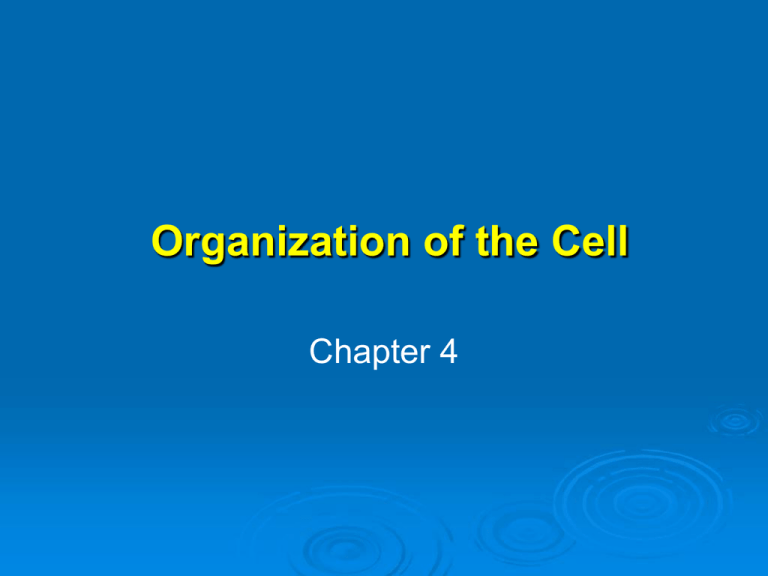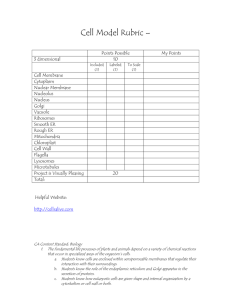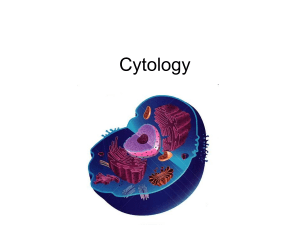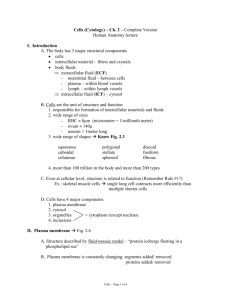Chapter 4 Notes-Cells
advertisement

Organization of the Cell Chapter 4 Learning Objective 1 • What is cell theory? • How does cell theory relate to the evolution of life? Cell Theory (1) Cells are basic units of organization and function in all living organisms (2) All cells come from other cells All living cells have evolved from a common ancestor Learning Objective 2 • What is the relationship between cell organization and homeostasis? Homeostasis • Cells have many organelles, internal structures that carry out specific functions, that help maintain homeostasis KEY CONCEPTS • Cell organization and size are critical in maintaining homeostasis Plasma Membrane • Plasma membrane • • • • surrounds the cell separates cell from external environment maintains internal conditions allows the cell to exchange materials with outer environment KEY CONCEPTS • Eukaryotic cells are divided into compartments by internal membranes • Membranes provide separate, small areas for specialized activities Learning Objective 3 • What is the relationship between cell size and homeostasis? Biological Size Mitochondrion Protein Amino Atom acids 0.1 nm 1 nm Red blood cells Chloroplast Typical bacteria Human egg Chicken egg Virus Nucleus Ribosomes Smallest bacteria 10 nm 100 nm Epithelial cell 1 μm 10 μm 100 μm Frog egg 1 mm Some nerve cells 10 mm 100 mm Adult human 1m 10 m Electron microscope Light microscope Human eye Measurements 1 meter = 1000 millimeters (mm) 1 millimeter = 1000 micrometers (μm) 1 micrometer = 1000 nanometers (nm) Fig. 4-1, p. 75 Surface to Volume Ratio • SVR ratio of plasma membrane (surface area) to cell’s volume • regulates passage of materials into and out of the cell • • Critical factor in determining cell size SVR 1 mm 2 mm 2 mm Surface Area (mm2) Surface area = height width number of sides number of cubes Volume (mm3) Volume = height width length number of cubes Surface Area/ Volume Ratio Surface area/ volume 24 (2 2 6 1) 8 (2 2 2 1) 3 (24 :8) 1 mm 48 (1 1 6 8) 8 (1 1 1 8) 6 (48 :8) Fig. 4-2, p. 76 Learning Objective 4 • What methods do biologists use to study cells? • How are microscopy and cell fractionation used? Microscopes • Light microscopes • Electron microscopes • superior resolving power Microscopes Light microscope Light beam Ocular lens Objective lens Specimen Condenser lens Light source (a) A phase contrast light microscope can be used to view stained or living cells, but at relatively low resolution. 100 μm Fig. 4-4a, p. 79 Transmission electron microscope Electron gun Electron beam First condenser lens (electromagnet) Specimen Projector lens (electromagnetic) Film or screen (b) The transmission electron microscope (TEM) produces a highresolution image that can be greatly magnified. A small part of a thin slice through the Paramecium is shown. 1 μm Fig. 4-4b, p. 79 Electron gun Electron beam First condenser lens (electromagnet) Secondary electrons Scanning electron microscope Second condenser lens Scanning coil Final (objective) lens Cathode ray tube synchronized with scanning coil Specimen Electron detector (c) The scanning electron microscope (SEM) provides a clear view of surface features. 100 μm Fig. 4-4c, p. 79 Cell Fractionation • Cell fractionation • • purifies organelles to study function of cell structures Cell Fractionation Centrifuge rotor Centrifugal force Centrifugal force Hinged bucket containing tube (a) Centrifugation. Due to centrifugal force, large or very dense particles move toward the bottom of a tube and form a pellet. Fig. 4-5a, p. 80 Centrifuge 600 x G 10 minutes Disrupt cells in buffered solution 30 minutes Nuclei in pellet Centrifuge supernatant 100,000 x G 90 minutes Low sucrose concentration Resuspend pellet layer on top of sucrose gradient Mitochondria, chloroplasts Microsomal pellet in pellet (contains ER, Golgi, plasma membrane) Sucrose density gradient Centrifuge supernatant 20,000 x G Layered microsomal suspension Plasma membrane Density gradient centrifugation 100,000 x G High Golgi sucrose concentration ER (b) Differential centrifugation. Cell structures can be separated into various fractions by spinning the suspension at increasing revolutions per minute. Membranes and organelles from the re-suspended pellets can then be further purified by density gradient centrifugation (shown as last step). G is the force of gravity. ER is the endoplasmic reticulum. Fig. 4-5b, p. 80 Layered microsomal suspension Centrifuge supernatant 100,000 x G Centrifuge 600 x G 10 minutes Disrupt cells in buffered solution Nuclei in pellet 30 minutes 90 minutes Plasma membrane Resuspend pellet layer on top of sucrose gradient Mitochondria, chloroplasts Microsomal pellet (contains ER, Golgi, in pellet plasma membrane) Sucrose density gradient Centrifuge supernatant 20,000 x G Low sucrose concentration Density gradient centrifugation 100,000 x G Golgi High sucrose concentration ER Stepped Art Fig. 4-5b, p. 80 Learning Objective 5 • How do the general characteristics of prokaryotic and eukaryotic cells differ? • How are plant and animal cells different? Prokaryotes • Prokaryotic cells • • • • • No internal membrane organization nuclear area (not nucleus) cell wall ribosomes flagella Prokaryotes Pili Storage granule Flagellum Ribosome Cell wall DNA Plasma membrane Nuclear area Capsule 0.5 μm Fig. 4-6, p. 81 Eukaryotes • Eukaryotic cells • • • membrane-enclosed nucleus cytoplasm contains organelles cytosol (fluid component) Animal Cells Chromatin Membranous sacs of Golgi Nuclear envelope Nucleolus Nuclear pores Nucleus Golgi complex Plasma membrane Lysosome Nuclear envelope Cristae Ribosomes Rough ER Rough and smooth endoplastic reticulum (ER) Smooth ER Centrioles Mitochondrion Fig. 4-8, p. 83 Plant Cells • Plant cells • • • • rigid cell walls plastids large vacuoles no centrioles Plant Cells Mitochondrion Cristae Membranous sacs Golgi complex Cell wall Plasma membrane Vacuole Chloroplast Granum Nucleus Smooth ER Nuclear envelope Stroma Nucleolus Nuclear pores Rough ER Ribosomes Chromatin Rough and smooth endoplasmic reticulum (ER) Fig. 4-7, p. 82 Learning Objective 6 • What are the three functions of cell membranes? Cell Membranes • Divide cell into compartments • Vesicles transport materials between compartments • Important in energy storage and conversion • Endomembrane system Learning Objective 7 • What are the structures and functions of the nucleus? The Nucleus • Control center of cell • • Nuclear envelope • • genetic information coded in DNA double membrane Nuclear pores • communicate with cytoplasm Nuclear Structures • Chromatin • • Chromosomes • • DNA and protein DNA condensed for cell division Nucleolus • • ribosomal RNA synthesis ribosome assembly The Nucleus Rough ER Nuclear pores Chromatin Nucleolus (b) 0.25 μm Nuclear envelope Nuclear pore Nucleoplasm ER continuous with outer membrane of nuclear envelope Outer nuclear envelope Nuclear pore 2 μm (a) Nuclear pore (c) proteins Inner nuclear envelope Fig. 4-11, p. 88 KEY CONCEPTS • Eukaryotic cells have nuclei containing genetic information coded in DNA Learning Objective 8 • What are the structural and functional differences between smooth ER and rough ER? Endoplasmic Reticulum (ER) • Network of folded membranes • • Smooth ER • • • • in cytosol lipid synthesis calcium ion storage detoxifying enzymes Rough ER • • ribosomes on outer surface assembles proteins ER ER lumen Mitochondrion Ribosomes Rough ER 1 μm Smooth ER Fig. 4-12, p. 90 Learning Objective 9 • Trace the path of protein synthesis: synthesis in the rough ER processing, modification, and sorting by the Golgi complex • transportation to specific destinations • • The Golgi Complex • Processes proteins synthesized by ER • Manufactures lysosomes • Cisternae • stacks of flattened membranous sacs Transport Vesicles • Formed by membrane budding • Move glycoproteins • • from ER to cis face of Golgi complex Carry modified proteins from trans face to specific destination Protein Synthesis Polypeptides synthesized on ribosomes are inserted into ER lumen. Ribosomes Sugars are added, forming glycoproteins. Rough ER Transport vesicles Glycoprotein deliver glycoproteins to cis face of Golgi. Glycoproteins modified further in Golgi. Glycoproteins move to trans face where they are packaged in transport vesicles. Glycoproteins transported to plasma membrane (or other organelle). Contents of transport vesicle released from cell. Plasma membrane cis face trans face Golgi complex Fig. 4-14, p. 92 KEY CONCEPTS • Proteins are • • • • synthesized on ribosomes processed in the endoplasmic reticulum processed by the Golgi complex transported by vesicles Learning Objective 10 • What are the functions of lysosomes, vacuoles, and peroxisomes? Other Organelles • Lysosomes • • Vacuoles • • enzymes break down structures store materials in plant cells Peroxisomes • produce and degrade hydrogen peroxide (catalase) Learning Objective 11 • Compare the functions of mitochondria and chloroplasts • How is ATP synthesized by each of these organelles? Mitochondria • Site of aerobic respiration • Double membrane • • • inner membrane folded (cristae) matrix (cristae and inner compartment) Important in apoptosis • programmed cell death Mitochondria Outer mitochondrial Inner mitochondrial membrane membrane Matrix Cristae 0.25 μm Fig. 4-19, p. 95 Aerobic Respiration • Breaks down nutrients using oxygen • Energy from nutrients packaged in ATP • CO2, H2O produced as by-products Plastids • Plastids • • • organelles that produce and store food in cells of plants and algae Chloroplasts • plastids that carry out photosynthesis Chloroplast Structure • Stroma • • fluid-filled space enclosed by inner membrane of chloroplast Grana • • stacks of membranous sacs (thylakoids) suspended in stroma Chloroplasts Outer membrane Inner membrane Stroma 1 μm Intermembrane Thylakoid space membrane Thylakoid lumen Granum (stack of thylakoids) Fig. 4-20, p. 96 Photosynthesis • Chlorophyll • • • green pigment in thylakoid membranes traps light energy Light energy converted to chemical energy in ATP • used to synthesize carbohydrates from carbon dioxide and water Mitochondria and Chloroplasts Aerobic respiration Mitochondria (most eukaryotic cells) Glucose Photosynthesis Chloroplasts (some plant and algal cells) Light Glucose Fig. 4-18, p. 95 KEY CONCEPTS • Mitochondria and chloroplasts convert energy from one form to another Learning Objective 12 • What are the structures and functions of the cytoskeleton? The Cytoskeleton • Microtubules • • • Microfilaments • • • hollow tubulin cylinders MTOCs and MAPs actin filaments important in cell movement Intermediate filaments • • strengthen cytoskeleton stabilize cell shape Microtubules α-Tubulin Dimer on Plus end β-Tubulin Minus end Dimers off (a) Microtubules are manufactured in the cell by adding dimers of α-tubulin and β-tubulin to an end of the hollow cylinder. Notice that the cylinder has polarity. The end shown at the top of the figure is the fast-growing, or plus, end; the opposite end is the minus end. Each turn of the spiral requires 13 dimers. Fig. 4-22a, p. 98 Intermediate Filaments Protofilament Protein subunits Intermediate filament (a) Intermediate filaments are flexible rods about 10 nm in diameter. Each intermediate filament consists of components, called protofilaments, composed of coiled protein subunits. Fig. 4-27a, p. 101 100 μm (b) Intermediate filaments are stained green in this human cell isolated from a tissue culture. Fig. 4-27b, p. 101 Microfilaments (a) A microfilament consists of two intertwined strings of beadlike actin molecules. Fig. 4-26a, p. 101 100 μm (b) Many bundles of microfilaments (green) are evident in this fluorescent LM of fibroblasts, cells found in connective tissue. Fig. 4-26b, p. 101 Cytoskeleton Plasma membrane Microfilament Intermediate filament Microtubule Fig. 4-21, p. 97 Centrosome • Main MTOC of animal cells • Usually contains two centrioles • Each centriole has 9 x 3 arrangement of microtubules Centrioles MTOC Centrioles 0.25 μm (a) In the TEM, the centrioles are positioned at right angles to each other, near the nucleus of a nondividing animal cell. Fig. 4-24a, p. 99 (b) Note the 9 x 3 arrangement of microtubules. The centriole on the right has been cut transversely. Fig. 4-24b, p. 99 A Kinesin Motor Vesicle Kinesin receptor Kinesin ATP ATP Minus end Plus end Microtubule does not move Fig. 4-23, p. 98 KEY CONCEPTS • The cytoskeleton is a dynamic internal framework that functions in various types of cell movement Learning Objective 13 • How do cilia and flagella differ in structure and function? Cilia and Flagella • Cilia and flagella • • • • thin, movable structures project from cell surface function in movement Cilia are short, flagella are long Cilia 0.5 μm (a) TEM of a longitudinal section through cilia and basal bodies of the freshwater protist Paramecium multimicronucleatum. Some of the interior microtubules are visible. Fig. 4-25a, p. 100 0.5 μm (b) TEM of cross sections through cilia showing 9 + 2 arrangement of microtubules. Fig. 4-25b, p. 100 0.5 μm (c) TEM of cross section through basal body showing 9 x 3 structure. Fig. 4-25c, p. 100 Outer pair of microtubules Dynein Plasma membrane Central microtubules (d) This 3-D representation shows nine attached microtubule pairs (doublets) arranged in a cylinder, with two unattached microtubules in the center. The dynein “arms,” shown widely spaced for clarity, are actually much closer together along the longitudinal axis. Fig. 4-25d, p. 100 (e) The dynein arms move the microtubules by forming and breaking cross bridges on the adjacent microtubules, so that one microtubule “walks” along its neighbor. Flexible linking proteins between microtubule pairs prevent microtubules from sliding very far. Instead, the motor action causes the microtubules to bend, resulting in a beating motion. Microtubular bend Linking proteins Dynein Pair of microtubules Fig. 4-25e, p. 100 Learning Objective14 • Describe the glycocalyx, extracellular matrix, and cell wall Cell Coat • Glycocalyx (cell coat) • • Surrounds cell Polysaccharides extend from plasma membrane ECM • Extracellular matrix (ECM) • • • Fibronectins • • • Surrounds many animal cell Carbohydrates and protein glycoproteins of ECM bind to integrins Integrins • receptor proteins in plasma membrane ECM Collagen Fibronectins Extracellular matrix Integrin Intermediate filament Microfilaments Plasma membrane Cytosol Fig. 4-28, p. 102 Cell Wall • Cellulose & other polysaccharides • • form rigid cell walls in bacteria, fungi, and plant cells Cell 1 Middle lamella Primary cell wall Multiple layers of secondary cell wall Cell 2 2.5 μm Fig. 4-29, p. 102 Typical Prokaryotic Cell CLICK TO PLAY Plant Cell Walls CLICK TO PLAY Cytoskeletal Components CLICK TO PLAY Common Eukaryotic Organelles CLICK TO PLAY Flagella Structure CLICK TO PLAY Motor Proteins CLICK TO PLAY The Endomembrane System CLICK TO PLAY




